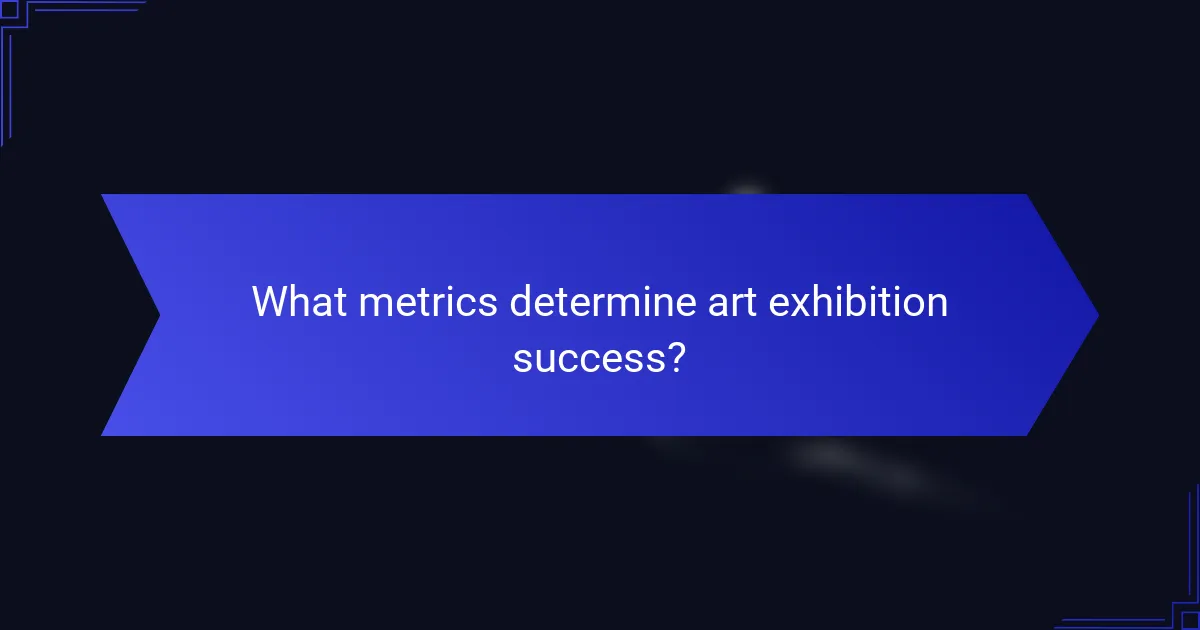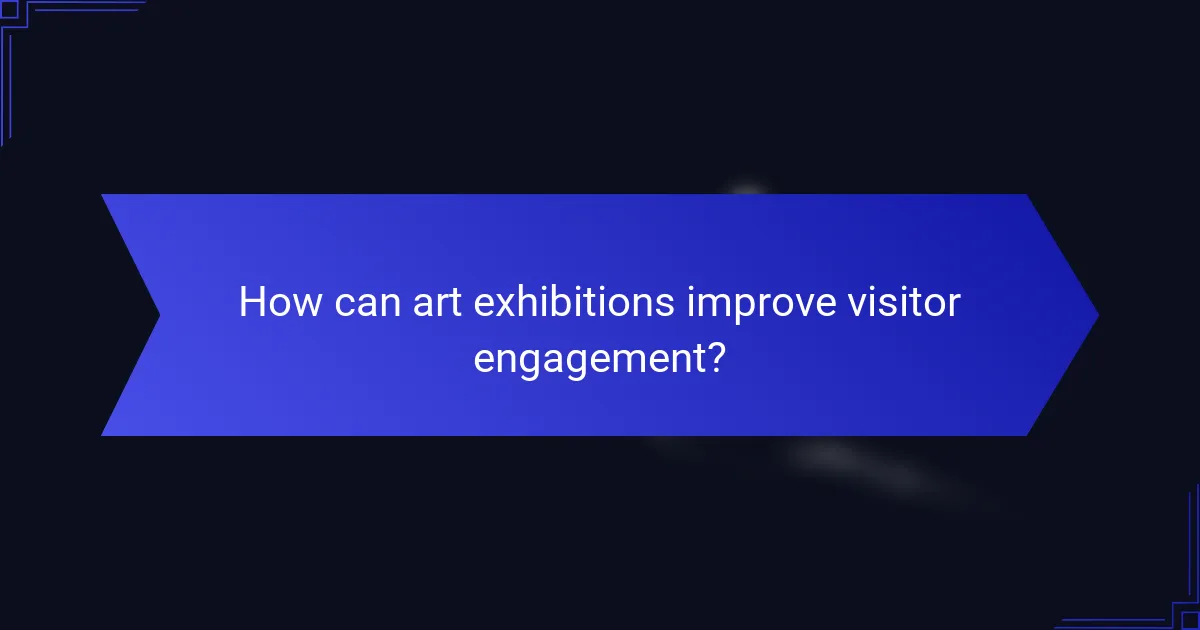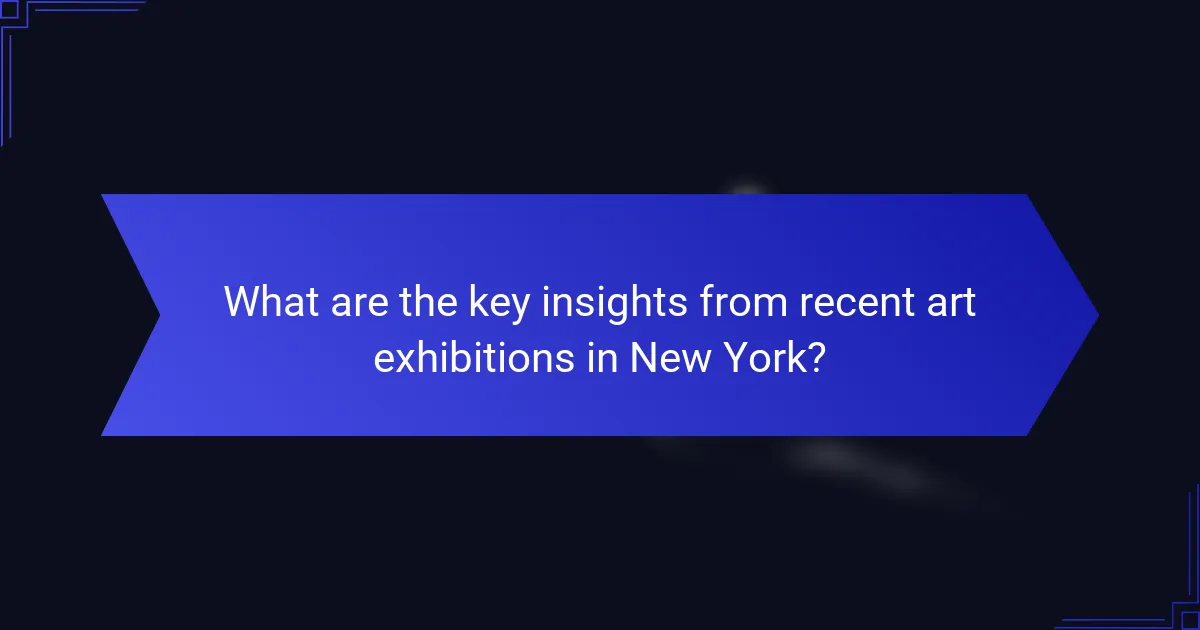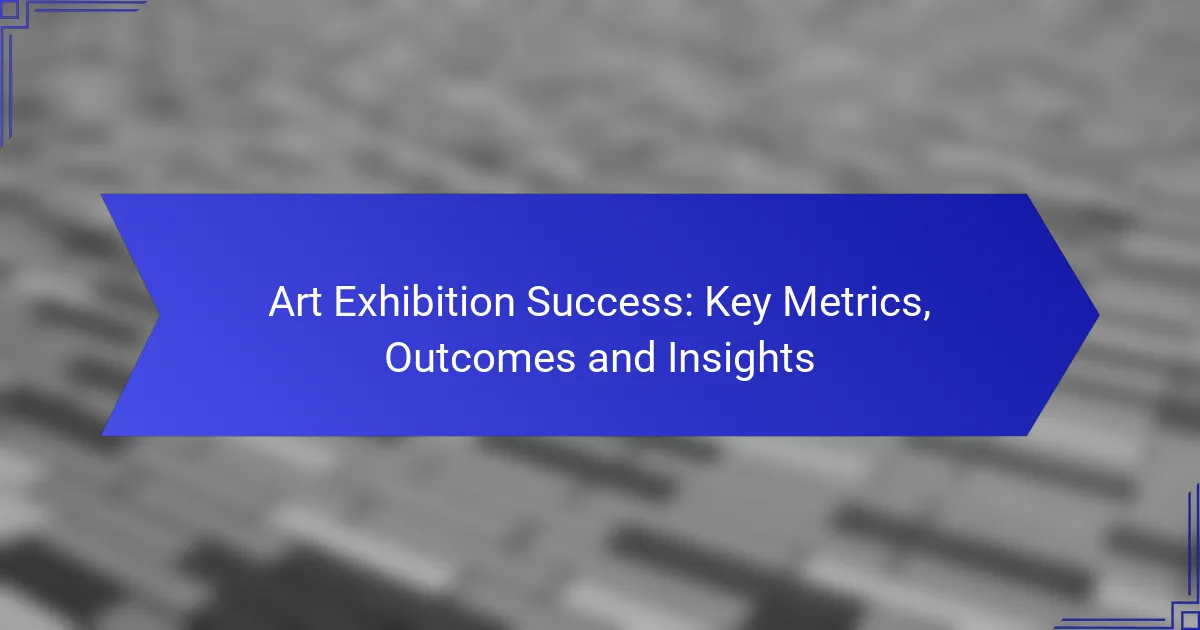Art exhibition success hinges on key metrics such as visitor attendance, sales revenue, and social media engagement, alongside qualitative feedback from attendees. By analyzing these outcomes, organizers can gain insights into the exhibition’s impact and effectiveness in connecting with audiences. Incorporating interactive elements can further enhance visitor engagement, fostering a deeper appreciation for the art and artists involved.

What metrics determine art exhibition success?
Art exhibition success is primarily determined by a combination of visitor attendance, sales revenue, social media engagement, press coverage, and feedback from post-exhibition surveys. Each of these metrics provides valuable insights into the exhibition’s impact and effectiveness in reaching its audience.
Visitor attendance numbers
Visitor attendance numbers are a fundamental metric for assessing the popularity of an art exhibition. High attendance often indicates strong interest and effective marketing strategies. Aim for a clear target based on venue capacity and past events; for instance, a successful exhibition might attract hundreds to thousands of visitors over its duration.
To maximize attendance, consider offering special events, guided tours, or artist talks. Tracking ticket sales and walk-in visitors can help gauge interest and inform future exhibitions.
Sales revenue from artwork
Sales revenue from artwork is a critical indicator of an exhibition’s financial success. This metric reflects not only the quality of the art but also the effectiveness of pricing strategies and marketing efforts. Successful exhibitions often see sales ranging from a few thousand to several hundred thousand dollars, depending on the artists and the market.
To enhance sales, ensure clear pricing, provide payment options, and promote featured artworks through various channels. Consider hosting exclusive previews for collectors to drive early sales.
Social media engagement rates
Social media engagement rates measure how well an exhibition resonates with audiences online. Metrics such as likes, shares, comments, and follower growth can indicate interest and reach. Effective campaigns might aim for engagement rates of 5-10% on platforms like Instagram and Facebook.
To boost engagement, create shareable content, use relevant hashtags, and encourage visitors to post their experiences. Engaging with followers through live updates and behind-the-scenes content can also enhance visibility.
Press coverage and reviews
Press coverage and reviews play a significant role in shaping public perception of an exhibition. Positive reviews from art critics and media outlets can enhance credibility and attract more visitors. Aim for coverage in both local and national publications to maximize exposure.
To improve press coverage, develop relationships with journalists and invite them to preview events. Providing press kits with high-quality images and exhibition details can facilitate better coverage.
Post-exhibition surveys
Post-exhibition surveys gather valuable feedback from attendees, helping to assess their overall experience and satisfaction. Surveys can cover aspects such as artwork quality, venue experience, and event organization. Aim for a response rate of around 20-30% for meaningful insights.
To encourage participation, offer incentives like discounts on future events or artwork. Analyze the feedback to identify strengths and areas for improvement, guiding future exhibitions toward greater success.

How can art exhibitions improve visitor engagement?
Art exhibitions can enhance visitor engagement by incorporating interactive elements that encourage participation and connection. By creating immersive experiences, exhibitions can foster a deeper appreciation for the artwork and the artists behind it.
Interactive installations
Interactive installations invite visitors to engage directly with the art, transforming passive observation into active participation. These installations can range from touch-sensitive displays to participatory sculptures where visitors contribute to the artwork’s evolution.
Consider incorporating technology, such as augmented reality, to enhance the interactive experience. For example, an installation could allow visitors to use their smartphones to see additional layers of art or information, making the experience more dynamic.
Workshops and artist talks
Workshops and artist talks provide opportunities for visitors to learn directly from creators and engage with the artistic process. These sessions can cover various topics, from techniques used in the artwork to discussions about the themes and inspirations behind the pieces.
Offering a mix of hands-on workshops and insightful talks can cater to different interests and skill levels. For instance, a painting workshop could attract budding artists, while a talk on contemporary art trends might appeal to art enthusiasts looking to deepen their understanding.
Virtual reality experiences
Virtual reality (VR) experiences can transport visitors into immersive environments that enhance their understanding of the artwork. By using VR, exhibitions can simulate the artist’s studio or recreate historical contexts, allowing visitors to experience art in a new dimension.
To implement VR effectively, ensure that the technology is user-friendly and accessible. Providing guided sessions can help visitors navigate the experience, making it enjoyable for those unfamiliar with VR. Consider offering a range of VR experiences to appeal to diverse audiences, from educational content to purely artistic explorations.

What are the financial outcomes of successful art exhibitions?
Successful art exhibitions can lead to significant financial outcomes, primarily through increased revenue from artwork sales, sponsorships, and merchandise. These metrics are crucial for evaluating the overall success and sustainability of an exhibition.
Increased artwork sales
One of the most direct financial outcomes of a successful art exhibition is increased artwork sales. When exhibitions attract a larger audience, the likelihood of selling pieces rises, often resulting in sales growth of 20-50% compared to previous events. This increase can be influenced by factors such as the quality of the artwork, marketing efforts, and the reputation of the artists involved.
To maximize artwork sales, galleries should consider pricing strategies, promotional events, and engaging storytelling around the pieces. Offering payment plans or financing options can also encourage buyers to invest in higher-priced works.
Higher sponsorship revenue
Successful exhibitions often attract higher sponsorship revenue, as brands seek to align themselves with popular cultural events. Sponsorships can range from a few thousand to several hundred thousand dollars, depending on the exhibition’s scale and audience reach. Establishing partnerships with local businesses and larger corporations can significantly boost financial support.
To secure sponsorships, art organizations should create compelling proposals that outline the exhibition’s potential impact, audience demographics, and marketing reach. Highlighting previous successes and providing clear visibility options for sponsors can enhance appeal.
Merchandise sales growth
Merchandise sales growth is another financial outcome of successful art exhibitions. Items such as catalogs, prints, and branded merchandise can provide additional revenue streams, often contributing 10-30% of total exhibition income. The right merchandise can enhance the visitor experience while promoting the artists and the exhibition itself.
To boost merchandise sales, galleries should consider offering exclusive items related to the exhibition theme or artist. Effective placement of merchandise stands and online sales options can also increase visibility and accessibility for potential buyers.

What role does marketing play in art exhibition success?
Marketing is crucial for art exhibition success as it helps attract visitors, generate buzz, and ultimately drive sales. Effective marketing strategies can significantly enhance visibility and engagement, leading to higher attendance and greater overall impact.
Targeted social media campaigns
Targeted social media campaigns are essential for reaching specific audiences interested in art. By utilizing platforms like Instagram and Facebook, galleries can create tailored ads that highlight exhibition details and artist profiles, ensuring they resonate with potential attendees.
Consider using demographic and interest-based targeting to maximize engagement. For example, targeting art enthusiasts aged 25-40 in urban areas can yield better results than a broad approach. Regularly posting engaging content, such as behind-the-scenes previews or artist interviews, can also maintain interest leading up to the event.
Email marketing strategies
Email marketing is a powerful tool for keeping your audience informed and engaged. Building a subscriber list allows galleries to send personalized invitations, updates, and exclusive previews to potential visitors, fostering a sense of community and anticipation.
To enhance effectiveness, segment your email list based on interests or past attendance. A/B testing subject lines and content can help identify what resonates best with your audience. Aim for a consistent schedule, sending reminders as the exhibition date approaches, but avoid overwhelming subscribers with too many emails.
Collaborations with influencers
Collaborating with influencers can amplify your exhibition’s reach and credibility. Influencers with a strong presence in the art community can share their experiences and promote the event to their followers, driving traffic and interest.
When selecting influencers, consider their audience alignment with your target demographic. Micro-influencers, who typically have smaller but highly engaged followings, can be particularly effective and often more affordable. Establish clear expectations regarding content and timelines to ensure a successful partnership.

What are the key insights from recent art exhibitions in New York?
Recent art exhibitions in New York have highlighted significant trends in visitor engagement and demographic shifts. Understanding these insights can help curators and organizers enhance future exhibitions and attract diverse audiences.
Trends in visitor demographics
Visitor demographics for art exhibitions in New York have evolved, with a noticeable increase in younger audiences, particularly those aged 18-35. This shift indicates a growing interest in contemporary art among millennials and Gen Z, who often seek interactive and immersive experiences.
Additionally, there is a rising trend in attendance from diverse cultural backgrounds, reflecting New York’s multicultural landscape. Organizers should consider incorporating diverse artists and themes to resonate with this expanding demographic.
To effectively engage these visitors, exhibitions can utilize social media platforms for promotion and create events that encourage participation, such as workshops or artist talks. This approach not only attracts a broader audience but also fosters community involvement and connection to the art presented.
